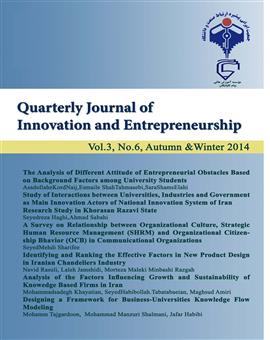-
-
List of Articles
-
Open Access Article
1 - The analysis of different attitude of entrepreneurial obstacles based on background factors among university students
asdollah kordnanich sara shamsollahi -
Open Access Article
2 - Study of Interactions between Universities, Industries and Government as Main Innovation Actors of National Innovation System of Iran (Research Study in Khorasan Razavi State)
SEYEDREZA HAGHI Ahmad sabahi -
Open Access Article
3 - Designing a Framework for Business-Universities Knowledge Flow Modeling
Mohammad Ghaem Tajgardoon mohammadtaghi manzouri habibi habibi -
Open Access Article
4 - Analysis of the factors influencing the growth and sustainability of Knowledge based firms in Iran
Mohammadsadegh Khayatian habibollah tataiyan mahdi elyasi -
Open Access Article
5 - relationship between Organizational Culture, Strategic Human Resource Management (SHRM) and Organizational Citizenship Behavior (OCB) in communicational organizations
mahdi sharifi hamzeh rayej mehrdad estiri -
Open Access Article
6 - Identifying and Ranking the Effective Factors in New Product Design in Iranian Chandeliers Industry
navid rasouli Morteza Maleli
-
The rights to this website are owned by the Raimag Press Management System.
Copyright © 2017-2025







